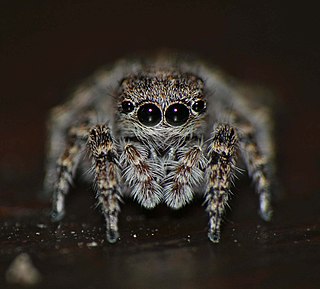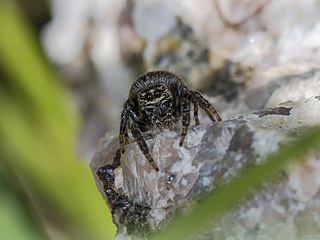
Evarcha is a genus of spiders in the family Salticidae with 85 species distributed across the world.

Hyllus is a genus of the spider family Salticidae. Most species occur in Africa and Madagascar, with many in Australasia and north to India. H. insularis is found in Greece and Iran, but it is considered misplaced in this genus, and is now Evarcha insularis.

Langelurillus is a spider genus of the family Salticidae. All the described species occur only in Africa.

Evarcha pinguis is a species of jumping spider in the genus Evarcha that lives in Ethiopia. The species was first described in 2008 by Wanda Wesołowska and Beata Tomasiewicz. The spider is larger than others in the genus, with a cephalothorax measuring 3.4 mm (0.13 in) long and an abdomen between 4.7 mm (0.19 in) long. The spider is dark brown and hairy apart from a lighter streak on the back of the carapace and a pattern of light chevrons down the back of the abdomen. The legs are brown, the front four being thicker and shorter than the rest. The copulatory organs are distinctive. The female has marked sclerotization to the edge of its epigyne. The male has not been described.

Evarcha bakorensis is a species of jumping spider in the genus Evarcha that lives in Guinea, Ivory Coast and Nigeria. It thrives in savanna grasslands. The species was first described in 2002 by Christine Rollard and Wanda Wesołowska. The spider is small, with a cephalothorax measuring between 1.6 and 1.8 mm long and an abdomen that is between 1.3 and 1.9 mm long. The female is larger than the male. The cephalothorax has a light brown topside, or carapace, yellow underside, or sternum, and darker sides. The abdomen is greyish-brown or brown and has a lighter pattern on it. The spider has generally brown legs. It has distinctive copulatory organs. The female has a large membrane in the centre of its epigyne while the male has a straight and blunt tibial apophysis, or projection on its palpal tibia.

Evarcha grandis is a species of jumping spider in the genus Evarcha that lives in Nigeria. The species was first described in 2011 by Wanda Wesołowska and Anthony Russell-Smith. It is larger than typically for the genus, which is reflected in the species name derived from the Latin word that means "large". The spider has a cephalothorax that is typically 3.6 mm (0.14 in) long and an abdomen 5.7 mm (0.22 in) long. It has a brown carapace with a black eye field and greyish-brown abdomen. It has long brown bristles on its clypeus, or face, and white lines on its cheeks. The spider's legs are dark brown. Apart from its size, the spider's copulatory organs are the most clear way to identify it. The female has pockets towards the midpoint, rather than the rear, of its epigyne, short insemination ducts and large spermathecae. The male has not been described.

Evarcha idanrensis is a species of jumping spider in the genus Evarcha that lives in Nigeria. It is named after Idanre Hill in Ondo State, where it was first found. The species was first described in 2011 by Wanda Wesołowska and Anthony Russell-Smith. The spider is hard to distinguish from other spiders in the genus. It has a cephalothorax measuring between 2.1 and 2.5 mm long and an abdomen between 2.2 and 3.5 mm long. It has a yellow carapace with a black eye field and light brown legs. The abdomen is brownish-grey with an indistinct pattern on its back. Apart from the size of the epigyne, the female's copulatory organs are similar to other members of the genus. The male has not been described.
Evarcha werneri is a jumping spider native to Ethiopia, Sudan to Uganda, Tanzania, Namibia and South Africa.
Pellenes cingulatus is a jumping spider species in the genus Pellenes that lives in Tanzania. It was first described in 2000.

Hyllus nigeriensis is a species of jumping spider in the genus Hyllus that is endemic to Nigeria. It lives in rainforest. The spider was first described in 2012 by Wanda Wesołowska and G. B. Edwards. A medium-sized spider, it typically has a cephalothorax 4.1 mm (0.16 in) long and an abdomen 4.0 mm (0.16 in) long. The abdomen is reddish-brown and narrower than the light brown carapace. Originally tentatively allocated to the genus Brancus, the species was allocated to Hyllus in 2022. Only the female has been described.
Evarcha prosimilis is a species of jumping spider in the genus Evarcha that lives in Kenya, South Africa. Tanzania, Uganda and Zimbabwe. It is ground-dwelling spider, thriving in leaf litter, but has also been observed living on the walls of houses and on grassy tussocks. More commonly found between November and April, the spider builds a nest of tightly-woven silk and will hunts flies and spiders, some of which are larger than itself. It a small spider, with a carapace that ranges in length between 2.1 and 2.4 mm and an abdomen that is between 1.7 and 3.2 mm. The female has a larger abdomen than the male that has a mottled pattern on its top consisting of whitish and brown patches or greyish-brown patches on a yellowish background. The species was first described in 2008 by Wanda Wesołowska and Meg Cumming, although examples had been found as early as 1938.

Hyllus rotundithorax is a species of jumping spider in the genus Hyllus that is endemic to Tanzania. It lives near rivers. The spider was first described in 2000 by Wanda Wesołowska and Anthony Russell-Smith. The spider is large, with a brown carapace 5.8 mm (0.23 in) long and an abdomen 6.8 mm (0.27 in) long. The species has a distinctive rounded thorax, after which it is named, and a long thin embolus. Only the male has been identified.

Hyllus ramadanii is a species of jumping spider in the genus Hyllus that is endemic to Tanzania. It lives in rocky environments. The spider was first described in 2000 by Wanda Wesołowska and Anthony Russell-Smith. The spider is medium-sized, with a brown carapace between 3.1 and 3.2 mm long and an abdomen 3.2 and 5.0 mm long. The female is larger than the male. It can be differentiated from other species in the genus by its coloration and copulatory organs. The male has a pattern of three white patches on its carapace and a horseshoe shape on its abdomen. The female has three irregular orange streaks on its carapace and a yellow pattern that looks like a tree on its abdomen.
Tanzania minutus is a species of jumping spider in the genus Tanzania that lives in South Africa and Tanzania. First described in 2000 by Wanda Wesołowska and Anthony Russell-Smith, it is a very small spider, which is recalled in its species name, a Latin word meaning small, with a carapace typically 0.8 mm (0.03 in) long and an abdomen between 0.8 and 0.9 mm (0.04 in) long. The spider is generally yellow with a brown patch in the middle of the carapace and a narrow stripe running down the top of the abdomen apart from the black eye field. The spider's legs are also yellow with black patches. Its pedipalps are orange and its spinnerets are darker, nearly black. The male has distinctive copulatory organs with a very short coiled embolus. The female has not been described.
Tanzania pusillus is a species of jumping spider in the genus Tanzania that lives in the country Tanzania. First described in 2000 by Wanda Wesołowska and Anthony Russell-Smith, the species was originally known as Lilliput pusillus but was renamed in 2008. it is a very small spider, which is recalled in its species name, a Latin word meaning diminutive, with a carapace and abdomen between 0.8 and 0.9 mm long. The spider is generally yellow apart from the dark brown eye field and grey top to its abdomen. The spider's legs are also yellow with black rings around their different segments. Its pedipalps are yellow and spinnerets are grey.The male has distinctive copulatory organs with a distinctive embolus that is shaped like a corkscrew. The female has not been described.
Tusitala proxima is a jumping spider that lives in Tanzania.
Tusitala unica is a jumping spider that lives in Tanzania.
Heliophanus pygmaeus is a jumping spider that lives in Senegal, Tanzania, South Africa and Zimbabwe.
Xuriella prima is the type species of jumping spider in the genus Xuriella first described in 2000 by Wanda Wesołowska and Anthony Russell-Smith. First discovered in Tanzania, it has also been identified in South Africa and Zimbabwe.

Evarcha zougoussi is a species of jumping spider in the genus Evarcha that lives in Ethiopia. The species was first described in 2022 by Wanda Wesołowska and Anthony Russell-Smith. It is a comparatively large spider, with an oval cephalothorax measuring between 2.7 and 3.3 mm long and an ovoid abdomen between 3 and 3.5 mm long. It has a pattern of a light streak down its carapace, the top of its cephalothorax, and a series of spots on its abdomen. In comparison, the spider's sternum, or underside of the cephalothorax, is a plain yellow. Its legs are generally light brown. Although only the female has been identified, it is clear that the spider's copulatory organs are distinctive, including the existence of a deep pocket in its epigyne and its bean-shaped spermathecae.








